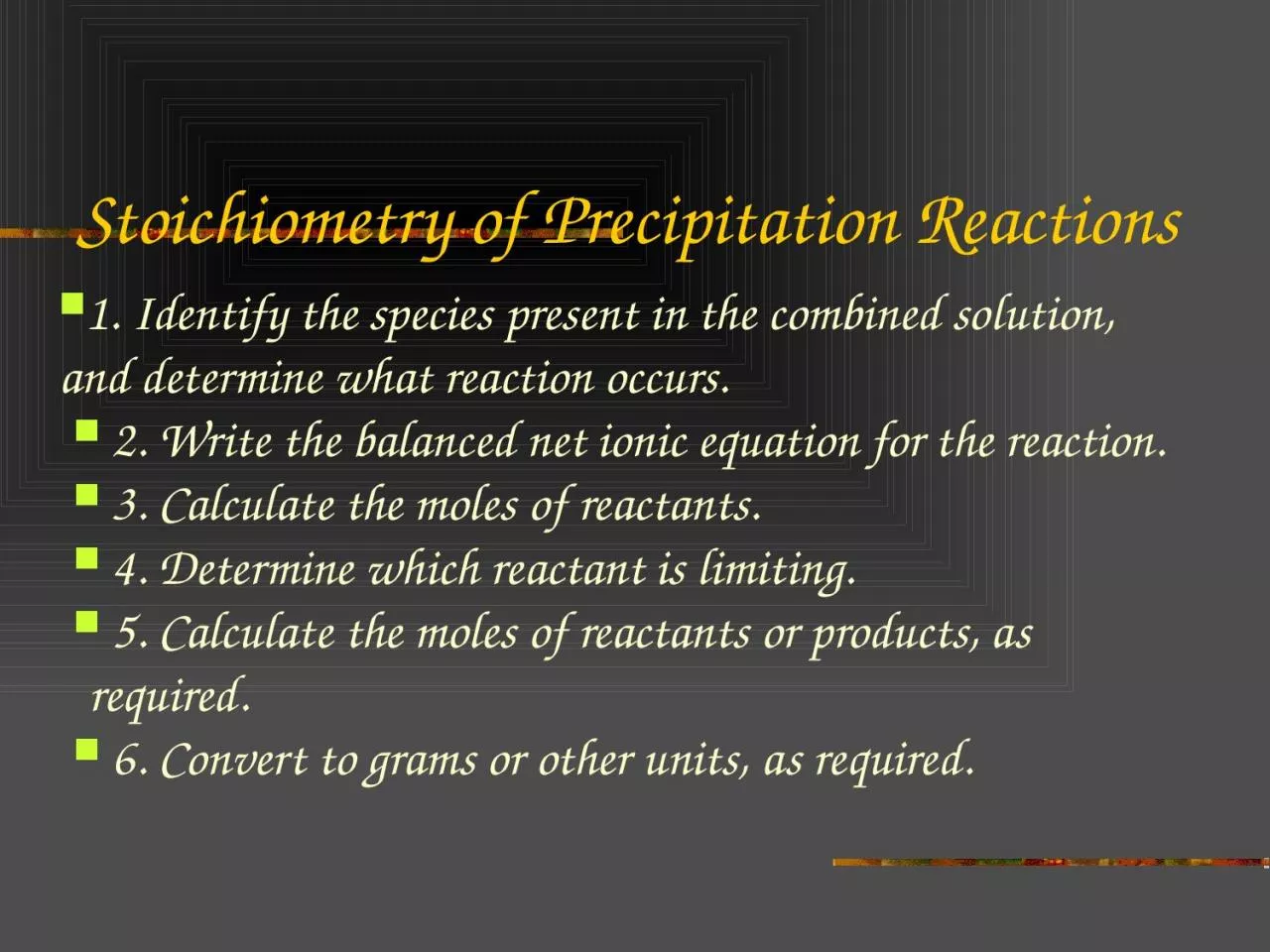

1 Identify the species present in the combined solution and determine what reaction occurs 2 Write the balanced net ionic equation for the reaction 3 Calculate the moles of reactants 4 Determine which reactant is limiting ID: 1039114
Download Presentation The PPT/PDF document "Stoichiometry of Precipitation Reactions" is the property of its rightful owner. Permission is granted to download and print the materials on this web site for personal, non-commercial use only, and to display it on your personal computer provided you do not modify the materials and that you retain all copyright notices contained in the materials. By downloading content from our website, you accept the terms of this agreement.
1. Stoichiometry of Precipitation Reactions1. Identify the species present in the combined solution, and determine what reaction occurs. 2. Write the balanced net ionic equation for the reaction. 3. Calculate the moles of reactants. 4. Determine which reactant is limiting. 5. Calculate the moles of reactants or products, as required. 6. Convert to grams or other units, as required.
2. Determining the Mass of Products Formed Calculate the mass of solid NaCl that must be added to 1.50 L of a 0.100 M AgNO3 solution to precipitate all the Ag+ ions in the form of AgCl.
3. Acid-Base ReactionsThe Bronsted-Lowry Definitions:An acid is a proton donor.A base is a proton acceptor.Arrhenius definitions:Acid generate protons (hydronium) Bases generate hydroxideLewis definitionsAcids are electron pair acceptorsBases are electron pair donors
4. Performing Calculations for Acid-Base Reactions1.List the species present in the combined solution before any reaction occurs, and decide what reaction will occur.2. Write the balance net ionic equation for this reaction.3. Calculate the moles of reactants. For reactions in solution, use the volumes of the original solutions and their molarities. 4. Determine the limiting reactant. 5. Calculate the moles of the required reactant and product.6. Convert to grams or volume (of solution), as required.
5. Example ProblemWhat volume of a 0.100 M HCl solution is needed to neutralize 25.0 mL of 0.350 M NaOH?In a certain experiment, 28.0 mL of 0.250 M HNO3 and 53.0 mL of 0.320 M KOH are mixed. Calculate the amount of water formed in the resulting reaction. What is the concentration of H+ or OH- ions in excess after the reaction goes to completion?
6. Acid-Base TitrationsVolumetric analysis is a technique for determining the amount of a certain substance by doing a titration.A titration is a process in which a solution of known concentration is used to determine the concentration of another solution through a monitored reaction.The equivalence point is reached when all of the moles of H+ ions present in the original volume of acid solution have reacted with an equivalent number of moles of OH- ions added. This is also known as the stoichiometric point.
7. TitrationAn acid-base indicator is a chemical that changes color once the equivalence point is reached. The endpoint of a titration is the point in a titration where the indicator actually changes color. Three requirements for a titration1. The exact reaction between titrant (known solution) and analyte (unknown solution or one you are analyzing) must be known (and rapid).
8. Three requirement (cont.)2. The stoichiometric (equivalence) point must be marked accurately. 3. The volume of titrant required to reach the stoichiometric point must be known accurately.
9. Problem solvingThe first step in the analysis of a complex solution is to write down the components and focus on the chemistry of each one.Take a big problem and look at the small problems within.
10. Neutralization TitrationA student carries out an experiment to standardize (determine the exact concentration of) a sodium hydroxide solution. To do this, the student weighs out a 1.3009-g sample of potassium hydrogen phthalate (KHC8H4O4, often abbreviated KHP. KHP (molar mass 204.22 g/mol) has one acidic hydrogen. The student dissolves the KHP in distilled water, adds phenolphthalein as an indicator, and titrates the resulting solution with the sodium hydroxide solution to the phenolphthalein endpoint. The difference between the final and initial buret readings indicates that 41.20 mL of the sodium hydroxide solution is required to react exactly with the 1.3009 g KHP. Calculate the concentration of the sodium hydroxide solution.
11. Neutralization AnalysisAn environmental chemist analyzed the effluent (the released waste material) from an industrial process known to produce the compounds carbon tetrachloride (CCl4) and benzoic acid (HC7H5O2), a weak acid that has one acidic hydrogen atom per molecule. A sample of this effluent weighing 0.3518 g was shaken with water, and the resulting aqueous solution required 10.59 mL of 0.1546 M NaOH for neutralization. Calculate the mass percent of HC7H5O2 in the original sample.